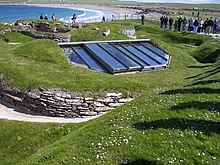Skara Brae
Skara Brae /ˈskærə ˈbreɪ/ is a stone-built Neolithic settlement, located on the Bay of Skaill in the parish of Sandwick, on the west coast of Mainland, the largest island in the Orkney archipelago of Scotland.
[12] The inhabitants of Skara Brae were makers and users of grooved ware, a distinctive style of pottery that had recently appeared in northern Scotland.
At some sites in Orkney, investigators have found a glassy, slag-like material called "kelp" or "cramp" which may be residual burnt seaweed.
Lloyd Laing noted that this pattern accorded with Hebridean custom up to the early 20th century suggesting that the husband's bed was the larger and the wife's was the smaller.
Additional support may come from the recognition that stone boxes lie to the left of most doorways, forcing the person entering the house to turn to the right-hand, "male", side of the dwelling.
[23] At the front of each bed lie the stumps of stone pillars that may have supported a canopy of fur, another link with recent Hebridean style.
House 8 is distinctive in other ways as well: it is a stand-alone structure not surrounded by midden;[26] instead it is above ground with walls over 2 metres (6.6 ft) thick and has a "porch" protecting the entrance.
[15] Childe originally believed that the inhabitants did not farm, but excavations in 1972 unearthed seed grains from a midden suggesting that barley was cultivated.
Euan MacKie suggested that Skara Brae might be the home of a privileged theocratic class of wise men who engaged in astronomical and magical ceremonies at nearby Ring of Brodgar and the Standing Stones of Stenness.
[30] Graham and Anna Ritchie cast doubt on this interpretation noting there is no archaeological evidence for this claim,[31] although a Neolithic "low road" that goes from Skara Brae passes near both these sites and ends at the chambered tomb of Maeshowe.
Evan Hadingham combined evidence from found objects with the storm scenario to imagine a dramatic end to the settlement: As was the case at Pompeii, the inhabitants seem to have been taken by surprise and fled in haste, for many of their prized possessions, such as necklaces made from animal teeth and bone, or pins of walrus ivory, were left behind.
One woman was in such haste that her necklace broke as she squeezed through the narrow doorway of her home, scattering a stream of beads along the passageway outside as she fled the encroaching sand.
[33] Although the visible buildings give an impression of an organic whole, certainly, an unknown quantity of additional structures had already been lost to sea erosion before the site's rediscovery and subsequent protection by a seawall.
For example, author Rodney Castleden suggested that "colons" found punctuating vertical and diagonal symbols may represent separations between words.
[44] These pins are similar to examples found in passage graves in the Boyne Valley, another piece of evidence suggesting a linkage between the two cultures.
[45] The eponymous Skaill knife was a commonly used tool in Skara Brae; it consists of a large stone flake, with a sharp edge used for cutting, knocked off a sandstone cobble.
Unusually, no Maeshowe-type tombs have been found on Rousay and although there are a large number of Orkney–Cromarty chambered cairns, these were built by Unstan ware people.
It is managed by Historic Environment Scotland, whose "Statement of Significance" for the site begins: The monuments at the heart of Neolithic Orkney and Skara Brae proclaim the triumphs of the human spirit in early ages and isolated places.
They were approximately contemporary with the mastabas of the archaic period of Egypt (first and second dynasties), the brick temples of Sumeria, and the first cities of the Harappa culture in India, and a century or two earlier than the Golden Age of China.
The report by Historic Environment Scotland, the Orkney Islands Council and others concludes that the entire Heart of Neolithic Orkney World Heritage Site, and in particular Skara Brae, is "extremely vulnerable" to climate change due to rising sea levels, increased rainfall and other factors; it also highlights the risk that Skara Brae could be partially destroyed by one unusually severe storm.






